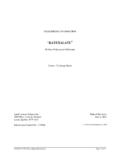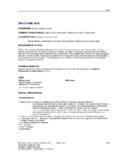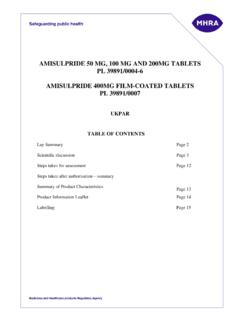Transcription of PRODUCT MONOGRAPH - Sanofi
1 CLOLAR (clofarabine for injection) Page 1 of 41 PRODUCT MONOGRAPH PrCLOLAR Clofarabine for injection 1 mg/mL (20 mg/20 mL) Antineoplastic Agent Sanofi -aventis Canada Inc. 2905 Place Laval, Quebec H7V 0A3 Date of Preparation: August 31, 2016 Submission Control No: 195475 s-a version dated August 31, 2016 CLOLAR (clofarabine for injection) Page 2 of 41 Table of Contents PART I: HEALTH PROFESSIONAL INFORMATION ..3 SUMMARY PRODUCT INFORMATION ..3 INDICATIONS AND CLINICAL USE ..3 CONTRAINDICATIONS ..3 WARNINGS AND PRECAUTIONS.
2 4 ADVERSE REACTIONS ..8 DOSAGE AND ADMINISTRATION ..19 OVERDOSAGE ..21 ACTION AND CLINICAL PHARMACOLOGY ..21 STORAGE AND STABILITY ..24 SPECIAL HANDLING INSTRUCTIONS ..24 DOSAGE FORMS, COMPOSITION AND PACKAGING ..24 PART II: SCIENTIFIC INFORMATION ..25 PHARMACEUTICAL INFORMATION ..25 CLINICAL TRIALS ..26 DETAILED PHARMACOLOGY ..29 TOXICOLOGY ..32 REFERENCES ..37 PART III: CONSUMER CLOLAR (clofarabine for injection) Page 3 of 41 PrCLOLAR Clofarabine for injection PART I: HEALTH PROFESSIONAL INFORMATION SUMMARY PRODUCT INFORMATION Route of Administration Dosage Form / Strength Nonmedicinal Ingredients Intravenous infusion Injection/ 1 mg/mL unbuffered normal saline (water for injection, USP, and sodium chloride, USP) INDICATIONS AND CLINICAL USE CLOLAR (clofarabine) is indicated for the treatment of pediatric patients 1 to 21 years old with relapsed or refractory acute lymphoblastic leukemia after at least two prior regimens.
3 This use is based on the induction of complete responses. Approval is based on objective response rates. No survival advantage has been demonstrated and palliative benefit was not evaluated. CONTRAINDICATIONS Hypersensitivity to clofarabine or any of the excipients (see DOSAGE FORMS, COMPOSITION AND PACKAGING). Symptomatic central nervous system involvement (see CLINICAL TRIALS) History of serious heart, liver, kidney or pancreas disease (see ADVERSE DRUG REACTIONS). Severe hepatic impairment (defined as elevated transaminases (AST and/or ALT) > 5 x ULN, and/or elevated bilirubin > 3 x ULN) or severe renal insufficiency (defined as creatinine clearance < 30 mL/min).
4 CLOLAR (clofarabine for injection) Page 4 of 41 WARNINGS AND PRECAUTIONS Serious Warnings and Precautions CLOLAR (clofarabine) must be administered under the supervision of a physician qualified in the use of antineoplastic agents. CLOLAR is associated with: Tumor Lysis Syndrome (TLS) (see Hyperuricemia below) Systemic Inflammatory Response Syndrome (SIRS)/Capillary Leak Syndrome, including fatal cases (see Systemic Inflammatory Response Syndrome (SIRS) and Capillary Leak Syndrome below) Enterocolitis, including fatal cases (see Gastro-intestinal below) Hemorrhage, including fatal cases (see Hematologic below) Stevens-Johnson syndrome, toxic epidermal necrolysis, including fatal cases (see Skin below) Hepatotoxicity, including fatal cases (see Hepatic/Biliary/Pancreatic below)
5 Renal failure/acute renal failure due to infections, sepsis, and TLS; some cases had a fatal outcome (see Renal below) General CLOLAR should be administered under the supervision of a qualified physician experienced in the use of antineoplastic therapy. Carcinogenesis and Mutagenesis Carcinogenicity studies have not been conducted. Clofarabine was clastogenic in mammalian cells in the in vitro chromosomal aberration assay and in the in vivo micronucleus assay in rats. Clofarabine was not mutagenic in bacteria (Ames assay) (see TOXICOLOGY).
6 Dehydration/Hypotension As with other chemotherapeutic agents, patients receiving CLOLAR may experience vomiting and diarrhea; they should therefore be advised regarding appropriate measures to avoid dehydration. Patients should be instructed to seek medical advice if they experience symptoms of dizziness, lightheadedness, fainting spells, or decreased urine output. CLOLAR administration should be stopped if the patient develops hypotension for any reason during the 5 days of administration. If hypotension is transient and resolves without pharmacological intervention, CLOLAR treatment can be re-instituted with a dose reduction (see DOSAGE AND ADMINISTRATION).
7 CLOLAR (clofarabine for injection) Page 5 of 41 Gastro-intestinal Occurrences of enterocolitis, including neutropenic colitis, cecitis, and C. difficile colitis, have been reported during treatment with clofarabine. This has occurred more frequently within 30 days of treatment, and in the setting of combination chemotherapy. Enterocolitis may lead to necrosis, perforation, hemorrhage or sepsis complications and may be associated with fatal outcome (see ADVERSE REACTIONS). Patients should be monitored for signs and symptoms of enterocolitis. Hematologic Obtain complete blood counts and platelet counts at regular intervals during CLOLAR therapy.
8 Suppression of bone marrow function should be anticipated. Severe bone marrow suppression, including neutropenia, anemia, and thrombocytopenia, has been observed in patients treated with CLOLAR. At initiation of treatment, most patients in the clinical studies had hematological impairment as a manifestation of leukemia. These patients are at risk of prolonged neutropenia when treated with CLOLAR. For all subsequent courses, recovery of absolute neutrophil count (ANC) to > 109/L prior to restarting therapy is recommended. In clinical trials, no dose reductions were permitted for hematological toxicities, including thrombocytopenia, except for neutropenia ( 109/L) lasting for more than 28 days (see DOSAGE AND ADMINISTRATION).
9 Patients with prolonged neutropenia (ANC 109/L for > 28 days) should undergo a bone marrow examination to exclude progressive disease. Hemorrhage, including cerebral, gastrointestinal and pulmonary hemorrhage, has been reported and may be fatal. The majority of the cases were associated with thrombocytopenia (see ADVERSE REACTIONS). Hepatic/Biliary/Pancreatic CLOLAR has not been studied in patients with hepatic impairment (serum billirubin > x ULN plus ALT and AST > 5 x ULN). In patients with mild to moderate hepatic impairment CLOLAR should be used with the greatest caution.
10 Avoid concomitant use of medications known to induce hepatic toxicity (see ADVERSE REACTIONS, DOSAGE AND ADMINISTRATION). Patients who have previously received a hematopoietic stem cell transplant (HSCT) may be at higher risk for hepatotoxicity suggestive of veno-occlusive disease (VOD) following treatment with clofarabine when used in combination (etoposide and cyclophosphamide). Severe hepatotoxic events have been reported in an ongoing Phase 1/2 combination study of clofarabine in pediatric patients with relapsed or refractory acute leukemia.









![Thymoglobulin (anti-thymocyte globulin [rabbit]) - …](/cache/preview/a/b/2/e/e/b/8/2/thumb-ab2eeb82468088f352549e7d8dab340f.jpg)





